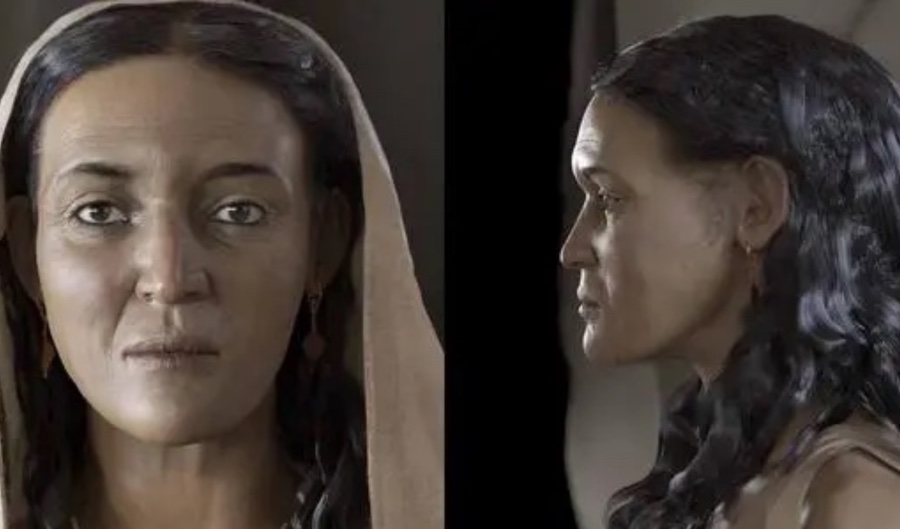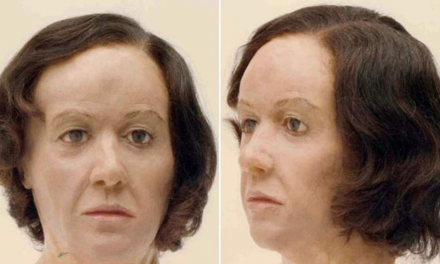A revolutionary technology has enabled us to come face-to-face with a woman from the Nabatean civilisation.
This breakthrough was achieved by a collaborative effort between archaeologists, forensic scientists, and model makers operating under the Saudi Royal Commission for AlUla (RCU).
Their efforts resulted in the reconstruction of the face of Hinat, an important figure from over 2,000 years ago, who was a member of the mysterious Nabatean civilization. Hinat was buried in a tomb in Hegra, Saudi Arabia, and is believed to have lived during the first century BC.
Creating the Facial Reconstruction
In 2019, a remarkably preserved tomb on the outskirts of Hegra yielded a discovery of around 80 individuals, including Hinat, whose well-preserved skeleton was in better condition than most in the tomb. Believed to be a wealthy and socially prominent Nabatean woman who lived during the first century BC, Hinat was selected for a facial reconstruction project.
The diverse team of archaeologists, anthropologists, forensic experts, and a 3D sculptor gathered in London in September 2019 to discuss Hinat’s attire and appearance, creating a character profile that included references to her clothes, hair, and jewellery.
By July 2020, the 3D reconstruction of Hinat’s face was complete and validated by experts. Specialists then moulded a silicon bust of her face and added strand by strand her makeup, earrings, and hair. They dressed her in linen similar to that found in tombs at Hegra.
This facial reconstruction of the Nabatean woman is a ground-breaking achievement and an opportunity to visualize the appearance of the Nabatean people for the first time. Dr. Christopher A. Tuttle, a Nabatean specialist, commented:
One of the problems in Nabatean archaeology and the study of the people is we lack images of them. They’re not portrayed very often in their own art, and for many decades of people working at Nabatean archaeological sites, we didn’t have very many human remains.
Dr. Christopher A. Tuttle, Nabatean specialist
Who Were the Nabateans and why were they important?
The Nabateans were an ancient Arab tribe who established a powerful kingdom in the region of present-day Jordan, Syria, and Saudi Arabia. They were known for their sophisticated culture, advanced trading system, and impressive architecture, including their famous rock-cut city of Petra.
The Nabateans were significant for several reasons. Their strategic location allowed them to control important trade routes between the Mediterranean Sea and the Arabian Peninsula, making them wealthy and influential traders. Their trade network stretched as far as China and India, and they became the primary suppliers of incense, spices, and other luxury goods to the Roman Empire.
In addition to their economic power, the Nabateans were also known for their unique and highly developed culture. They had their own written language, which was a variation of Aramaic, and their religious practices were a mixture of polytheism and ancestor worship. Their architecture, including their monumental tombs and the famous city of Petra, which was carved into the red sandstone cliffs, is considered a remarkable achievement of engineering and art.
The Nabateans played an important role in the ancient world, influencing the culture, religion, and trade of the surrounding regions.
A fantastic insight into the Nabatean civilisation
The reconstruction of Hinat’s face is a significant achievement that provides valuable insights into the mysterious Nabatean civilisation. This groundbreaking accomplishment showcases how technology, particularly artificial intelligence (AI), has revolutionised the field of archaeology and history.
As of Monday, 6th February 2023, the facial reconstruction of the Nabatean woman is on display at the Hegra Welcome Centre in AlUla, marking an exciting development fifteen years after Hegra was recognised as the first UNESCO World Heritage Site in Saudi Arabia in 2008. The RCU is optimistic that more noteworthy discoveries are on the horizon, as archaeologists continue to laboriously explore the historical secrets of the AlUla region.




